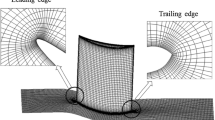Abstract
Effects of inlet boundary layer suction on the vortex structure and cascade loss in a highly loaded compressor cascade were investigated experimentally. Ink-track visualization was undertaken on cascade endwall and the blade surface. Ten traverse planes from upstream to downstream of the cascade in a rectangular wind tunnel were measured by an L-shaped five-hole probe. These tested planes revealed the process of emergence, development and decline of several principal vortices as well as the corresponding additional losses. Details of ink-track visualization displaying the secondary flow behavior of boundary layer upon endwall and blade surface assist to make judgment on vortex evolution. Inspection of the vortex structure revealed that highly loaded compressor was characterized by large-scale vortices in the endwall region. After suction, these vortices are all well organized and under control. Among all of them, passage vortex is most sensitive to the variation of the inlet boundary layer, and its main function is to spread low-energy fluid rather than to produce loss. On the other hand, a wall vortex and a concentrated shedding vortex take place inside and after the cascade, respectively, and engender considerable accompanying loss as they dissipate. The effects of inlet boundary layer suction on them are correspondingly weaker. About one forth of the total loss in the baseline cascade was eliminated when boundary layer suction flow rate reaches 2.5 % of the inlet mass flow. The feasibility of simplifying the suction system is also verified through this work.









Similar content being viewed by others
Abbreviations
- B :
-
Axial blade chord
- b :
-
Blade chord
- d :
-
Suction slot width
- h :
-
Blade height
- i :
-
Incidence
- P :
-
Pressure
- Re :
-
Reynolds number
- t :
-
Blade pitch
- U :
-
Inlet velocity
- u :
-
Axial component of velocity
- v :
-
Circumferential component of velocity
- w :
-
Spanwise component of velocity
- x :
-
Circumferential direction
- y :
-
Spanwise direction
- ORI:
-
Baseline scheme without suction slot
- EW0:
-
Schemes with suction slot on the endwall
- CSV:
-
Concentrated shedding vortex
- CV:
-
Corner vortex
- PV:
-
Passage vortex
- WV:
-
Wall vortex
- α 1P :
-
Inlet metal angle
- α 2P :
-
Outlet metal angle
- β :
-
Suction flow rate relative to inlet mass flow
- β t :
-
Stagger angle
- θ :
-
Blade camber angle
- ρ :
-
Density
- σ :
-
Chord to pitch ratio, solidity
- ω :
-
Total pressure coefficient
- Ω Z :
-
Axial component of vorticity
- 0:
-
Stagnation
- 1:
-
Inlet
- 2:
-
Outlet
- v :
-
Velocity
- t :
-
Total
- m :
-
Overall mass-averaged
- —:
-
Relative value
References
Agrawal A, Djenidi L, Antonia RA (2010) Near-field measurements and development of a new boundary layer over a flat plate with localized suction. Exp Fluids 48:747–762
Gbadebo SA, Cumpsty NA, Hynes TP (2005) Three-dimensional separations in axial compressors. ASME J Turbomach 127(2):331–339
Guo S, Chen S, Song Y, Song Y, Chen F (2010) Effects of boundary layer suction on aerodynamic performance in a high-load compressor cascade. Chin J Aeronaut 23(2):179–186
Han W, Lu H, Lu W, Wang Z (1994) The influence of thicknesses of inlet boundary layers on losses in cascades of high-turning curved blades. J Eng Thermophys 15(3):391–394
Han W, Lu H, Lu W, Wang Z (1995) Effect of curving of heavy duty blades on wall flow. J Aerosp Power 10(2):175–178
Kang S (1993) Investigation of the three dimensional flow within a compressor cascade with and without tip clearance. Ph.D. Thesis. Dept. of Fluid Mechanics, Vrije Universiteit Brussel
Karsten L, Robert M, Sebastian S (2012) Non-symmetrical boundary layer suction in a compressor cascade. J Theor Appl Mech 50(2):455–472
Kerrebrock JL, Reijnan DP, Ziminsky WS, Smilg LM (1997) Aspirated compressors. ASME Paper, 97-GT-525, Orlando
Kerrebrock JL, Drela MA, Merchant AA, Schuler BJ (1998) Family of designs for aspirated compressors. ASME Paper, 98-GT-196
Loughery R, Horn RA (1971) Single stage experimental evaluation of boundary layer blowing and bleed techniques for high lift stator blades. NASA, CR-54573
Merchant AA, Drela M, Kerrebrock JL (2000) Aerodynamic design and analysis of a high pressure ratio aspirated compressor stage. ASME Paper 2000-GT-619
Merchant AA, Adamczyk JJ, Kerrebrock JL, Braunscheidel E (2004) Experimental investigation of a high pressure ratio aspirated fan stage. In: Proceedings of the ASME turbo expo pp 493–502
Oyewola O, Djenidi L, Antonia RA (2005) Spanwise vorticity measurements in a perturbed boundary layer. Exp Fluids 39:152–155
Reijnen DP (1997) Experimental study of boundary layer suction in a transonic compressor. PhD Thesis. MIT, Cambridge, MA
Schuler BJ, Kerrebrock JL, Merchant AA, Drela M (2000) Design, analysis, fabrication and test of an aspirated fan stage. ASME Paper 2000-GT-618
Seal CV, Smith CR (1999) The control of turbulent end-wall boundary layers using surface suction. Exp Fluids 27:484–496
Song Y, Chen F, Yang J, et al (2005) A numerical investigation of boundary layer suction in compound lean compressor cascades. ASME Paper GT2005-68441
Wennerstrom AJ (1990) Highly loaded axial flow compressor history and current development. J Turbomach 112:567–578
Acknowledgments
The present study was supported by the Fundamental Research Funds for the Central Universities of China (DUT11RC(3)78), Specialized Research Fund for the Doctoral Program of Higher Education of China (No. 20112125120009) and the National Natural Science Foundation of China (No. 51206013). The authors are grateful to these supports.
Author information
Authors and Affiliations
Corresponding author
Rights and permissions
About this article
Cite this article
Guo, S., Lu, H., Chen, F. et al. Vortex control and aerodynamic performance improvement of a highly loaded compressor cascade via inlet boundary layer suction. Exp Fluids 54, 1570 (2013). https://doi.org/10.1007/s00348-013-1570-y
Received:
Revised:
Accepted:
Published:
DOI: https://doi.org/10.1007/s00348-013-1570-y




